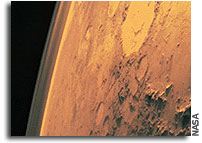Simulating Mars on Earth

The possibility of life on Mars has been debated almost since the invention of the telescope–annual growth and shrinkage of the martian ice caps and seasonal changes in color were observed by astronomers such as Herschel and Whewell in the 18th and 19th centuries. Late in the 19th century, Schiaparelli reported the existence of linear features he called “canali”, and this led to speculation by Lowell (among others) that the Red Planet might host a civilization more advanced than our own.
The arrival of instrumented spacecraft, beginning with Mariner IV in 1964, showed a cratered, dry, cold planet that looked almost as inhospitable as our Moon; but later missions provided evidence of liquid water on Mars in the recent past. This has led to speculation about whether simple forms of life, like bacteria, might exist on Mars. The thin atmosphere of Mars does little to block out damaging radiation from the sun, and the surface of Mars seems to be sterilized by caustic chemicals like hydrogen peroxide, but scientists still hold out hope that life on Mars could survive protected below the surface.
Now, building on a tradition of ground-based simulation that extends back to 1958, a new series of experiments, conducted by an interdisciplinary research team from the Faculty of Natural Sciences of the University of Aarhus, Denmark, suggests that indeed bacteria could survive beneath the martian soil.
The team constructed a Mars Environmental Simulation Chamber (MESCH), from which air is removed with a vacuum pump, and replaced with a thin mixture of gases equivalent to those in the martian atmosphere. The chamber has a double wall cooled with liquid nitrogen to simulate the cold temperatures experienced in the martian night.
Samples of soil in glass cylinders are placed in the chamber’s steel sample tubes through a small air-lock, then rotated on a carousel; exposing one sample at a time to ultraviolet-rich light from a xenon-mercury arc lamp. Cycling samples through the light beam produces a temperature rise and fall that mimics the diurnal temperature variation on Mars. The atmosphere in the chamber is sampled and subjected to molecular gas analysis to determine how the soil (and any bacteria it may contain) interacts with the atmosphere.
Shining a Light on Mars
Clifford A. Cerbus is a research physicist with the University of Dayton Research Institute, and has worked for 20 years on a space environment simulation system at the U.S. Air Force Research Laboratory Materials and Manufacturing Directorate in Dayton, Ohio. He expressed concern about the high intensity of the ultraviolet light generated by the xenon-mercury lamp used in MESCH, which is approximately 35 times as intense as the sun at Mars’ surface. While this enables accelerated testing, in which a few hours in the simulator simulates several days on Mars, Cerbus wonders if the results would be representative of what actually takes place on the martian surface.
“Yes, that is a problem,” concedes Professor Kai Finster, a member of the MESCH team. “We have plans to reduce the intensity by filters to levels more representative of those on Mars. We are also thinking of other light sources that represent a different spectrum and/or intensity, such as a solar simulator or other types of UV lamps. However, in the first round of experiments we were interested in seeing whether we could see any effect at all.”
So far, the University of Aarhus team has only published results with samples of sand, which demonstrated that the system produces temperature variations comparable to those on the martian surface. However, Finster says that additional tests have since been conducted on samples containing freeze-dried bacteria from Arctic permafrost. While exposure to 80 days in the simulated martian environment essentially sterilized the topmost two centimeters of the simulated sample core, bacteria were “relatively unaffected” in the rest of the 30 centimeter sample tubes. This result, presented in a paper which is due to appear soon in the journal Astrobiology, suggests that some form of life could exist below the martian surface.
The Faculty of Natural Sciences supported the construction of the MESCH instrument, and the experiments are supported by the Danish Natural Science Research Council.









